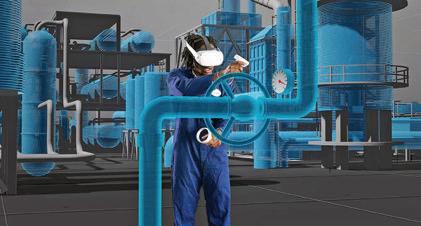
1 minute read
AUTOMATION TRENDS
trends putting pressure on industrial companies to improve their training programs. He said, “More than ever, industry needs training and development solutions that empower workers to improve plant performance, uptime, reliability, and safety. One of the best ways to do this is by simulating real-world environments and rare, but critical plant operation and maintenance scenarios to enable safe, handson learning away from the hazards of a plant.”
Emerson, for example, is using simulation to train refinery workers in Canada. Working with the refinery, Emerson developed a digital twin of the refinery’s production control system integrated with a high-fidelity simulator. Here, Emerson’s DeltaV Simulate virtual control system is used to mirror the refinery’s operator stations, engineering stations, process controllers, and system functions. Emerson’s Mimic software then simulates the processes, equipment, transmitters, and final control elements with operation-based modeling objects.
This system provides trainees with virtual controls, graphics, and alarms identical to those in the refinery and allows the use of all Emerson DeltaV software for training and development without the refinery having to purchase duplicate control hardware and system licenses.
Another application benefitting from simulation is training workers on computer numerical control (CNC) machines, such as milling machines, routers, lathes, and laser cutters. Siemens o ers a CNC training platform for creating and operating a CNC digital twin using the company’s Sinumerik 840D numerical control (NC) and NX software.
Trainees can operate an o ine digital twin of a CNC machine at their own PC as well as safely test and optimize NC programs without potentially damaging the real machine.
And Honeywell recently released an updated version of its Immersive Field Simulator, IFS-R120, described as a virtual reality (VR) and mixed-reality training tool based on a digital twin of a plant’s operations. With this technology, events like primary failures and switchovers, as well as cable and power supply failures, can be simulated.

Gamifi cation
Though not a new concept, gamification is a trend gaining ground in the simulation software arena. The Merriam-Webster dictionary defines gamification as the process of adding games or game-like elements to a learning a task to encourage participation.
The updated version of Honeywell’s IFS-R120 teams virtual and mixed reality with a digital twin to simulate real-life industrial events. Source: Honeywell
According to 3D game tech company Juego Studios, gamification training simulations are a good way to package complex content into interactive visual modules. Trainees learn complex tasks within a game-like environment. Realistic simulations make dry content interesting while enabling better understanding and memory retention.
Juego’s Unity3D game engine creates immer-




